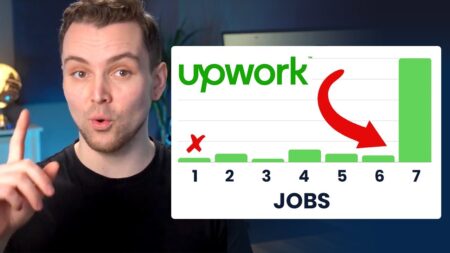As a freelancer, you have to operate your career as a business. You may be highly skilled in your service, but you’ll also have to learn how to sell that service.
That’s where negotiation comes into play. With some preparation and education, it’s possible to become a pro at negotiations, which is vital for ensuring that you and your client can agree on rates and terms that work for both parties.
In this article, we’ll teach you how to negotiate your freelance rates with confidence and ease. We’ll start by discussing establishing freelance rates, so you have a solid negotiation baseline. From there, we’ll learn some actionable tips and techniques for negotiating these rates.
How to Establish Your Freelance Rates
Before you get into negotiations, it’s crucial to have established pricing for your services. If you start negotiations with too much flexibility, you’ll leave yourself vulnerable to being taken advantage of.
Money Note: If an extra $1K–$5K/month would change your 2026 goals (debt, savings, travel, freedom), you’ll want to catch this: free live workshop from a freelancer who’s earned $4M+ online. No fluff. No gimmicks. A real roadmap. 👉 Watch the training or save your seat here »
By entering into negotiations with well-planned pricing, you’ll be able to reach a fair rate with mutually favorable terms for both you and the client.
If you’re a veteran freelancer, your rates are likely well-defined. If this is true for you, skip ahead to the next section!
1. Know your audience
Understanding your audience is the first step for setting your rates. You need to know who you can serve and the benefits and returns they’ll get from investing in your services.
For example, if you’re going after B2B businesses that sell higher-ticket items, they’ll be willing and able to pay more for a service that generates leads.
On the flip side, a small retail business with lower-ticket items doesn’t gain as significant of a return per lead, so it probably won’t be able to afford as much for lead generation.
2. Study your competitors
Understanding how your competitors price their services and why is a huge part of setting your freelance rates. It’ll help you understand the standard rate for the type of services you offer.
While you don’t need to match these rates exactly, understanding what others charge will help you position yourself in the market. You can decide if you want your rates to be more competitive or to position services as more luxury or advanced options.
3. Determine your absolute minimum rate
Another vital part of setting your rates is having a baseline for the minimum you can charge and still make enough money. This should be based on your operating costs and desired income.
Make sure you factor in taxes, as well. Many freelancers operate as sole proprietors or single-member LLCs. In these situations, you usually have to pay your own taxes, so it’s not something you put on the client. However, you should still factor it in as a cost.
Depending on the structure of your business, you might have different tax implications. You may need to charge sales tax or follow different tax regulations. These factors can be part of the rate negotiation discussion.
4. Calculate your rates
Once you’ve established your baseline pay, it’s time to crunch your numbers to set your rates for your various offers or packages.
If you charge an hourly rate, this should be pretty straightforward. However, calculating your rates will be more involved if you charge a flat rate per project. Tiered pricing will take some calculations to find the right balance of inflation and reductions based on the scope.
For example, if you’re a content writer, you likely have a typical per-word rate you charge. With that, you’ll likely inflate that rate for shorter articles, and you may offer a discount for longer articles.
5. Showcase your prices
After you’ve determined the rates you’d like to charge, it’s time to document them in a branded rate sheet. This should be a nicely designed PDF that defines your rates for packaged or individual services.
The purpose of this document is to add to your website or to send along to leads. It helps prospective quickly assess if your services are within their budget.
Feel free to inflate your prices on your rate sheet. This will give you some wiggle room during negotiations since you can give prospective clients a “better” deal without compromising the amount you want to make.
How to Negotiate Your Freelance Rates
Once your rates are set, and sales initiatives produce leads, it’s time to move toward negotiations. Successful negotiations should take prospects from the proposal phase through the contract phase.
1. Take a personalized approach
When entering negotiations, remember that even though your client is likely a business, a human is getting the deal done. That’s why it’s imperative to take a personalized approach to negotiations.
Study the person you’ll be negotiating with beforehand to find common ground. A quick glance at their LinkedIn or other professional profiles should give you a bit of context on where they are from and what sort of experiences they have.
Doing this will help you better understand who you’re speaking to and hopefully help make a more meaningful connection.
2. Help leads understand your rates
Although negotiations are near the end of the sales funnel, they still require some sales efforts. With that, you may need to justify your rates to help prospects understand how you’ve come up with that dollar amount.

As an example, there are many freelance professionals who work in the multimedia industry as voice actors providing services such as voice over.
In their work, in this case, they have to create assets that help justify why rates have increased.
In order to justify the rates, it is fair to justify and demonstrate one’s expertise and value added while also ensuring fair compensation based on one’s talent.
3. Showcase the value of your services
Negotiating freelance rates with confidence and ease is a skill that empowers freelancers in various industries to secure fair compensation for their expertise and services.
It’s about understanding your value and effectively conveying it to potential clients. However, this skill extends far beyond the world of freelancing.

Consider, for instance, freelance photographers who offer their services to real estate professionals. They, too, must negotiate their rates while understanding the value they bring to a real estate agent’s business. They should showcase past profitable real estate leads for agents so prospective clients understand the value of the photographer’s services.
4. Know when to compromise
Compromise is an essential part of negotiations for freelancers. Sometimes, you must adjust the terms and rates to best suit you and your prospective client.
On this note, don’t be too quick to discount your rates to close a deal. We discussed earlier that you should inflate your rates to make room for discounts, which is fine. However, discounting below the minimum you’ve set for yourself will likely put you in an uncomfortable position.
Tips for Setting and Negotiating Freelance Rates
Now that you’re more familiar with setting and negotiating freelance rates, let’s discuss some tips for streamlining these processes.
1. Adjust your rates as needed
Although it’s essential to hold your ground regarding your rates, you may find that your rates need to be adjusted. These adjustments could be raising your standard rates or lowering them. It’ll vary based on the scenario.
For example, if you encounter negotiations with several prospects and they all agree to your terms and rates with no resistance, it may be time to start charging more. If you’re finding that no prospects are biting at your offer, yet you’re confident that you’re in the right market, it may be time to reduce your prices.
It’s also reasonable to raise your prices as you gain more experience and work with more clients. You may even consider routine price rises to account for inflation.
2. Be transparent about fees
Extra fees can be pesky for clients, but when done right, they’re often necessary when running a freelance business. You may be tempted to hide these fees in the contract rather than be transparent about them.
However, it’s best to be upfront and honest about these things to create the foundation for a trusting relationship with prospective clients. Any additional fees that may arise should be laid out during negotiations.
For example, you could include a rush fee on projects requiring work to be completed quicker than what you’ve added in your contract.
Also, note late fees so prospects understand the consequences of missing payment due dates.
3. Prepare case studies
As a freelancer, showcasing your track record can significantly bolster your position at the negotiation table. Case studies showcase the actual results your services have helped clients achieve.
For instance, you can leverage your success stories if you specialize in social media management. Let’s say you helped a previous client gain substantial free followers on Instagram, as well as increased engagement on other social media like Facebook.
This social proof demonstrates your expertise and highlights your ability to drive results. It reinforces your position for successful rate negotiations.
4. Look at the bigger picture
As we mentioned, your rates will change as you grow. You may need additional financial support for smaller-ticket projects if you’re just starting out and building a clientele.
A personal loan can provide the financial cushion needed to focus on your freelance career without the constant worry of unforeseen expenses. It can be a safety net, allowing you the freedom to hone your skills and build a portfolio.
However, be mindful of the terms and ensure it’s a step that supports, not hinders, your financial journey.
Your worth is tangible, and with preparation, including considering financial support like a personal loan, you’ll be ready to negotiate your freelance rates with poise.
5. Consider international implications
For many online freelancers, location independence is a major perk. Working with clients both near and far is very appealing, as well.
This knowledge becomes especially vital when operating globally, where differences in local regulations, currencies, and international money transfers come into play.
Being well-versed in the intricacies of tax liabilities and the associated costs of transferring money internationally becomes crucial for freelancers working with global companies.
Companies like Remote HR can streamline processes like payroll, taxes, and currency conversions. Whether you’re on the receiving end of international payroll or need a hand setting up a freelancer you’ve hired to help grow your business, professional services like this are a game changer.
6. Accept different payment methods
Clients may prefer different payment methods based on ease of payment, associated fees, etc. Accepting different payment methods may be a perk for your clients that’ll help you negotiate.
Freelancing is no stranger to the world of blockchain and crypto. Many freelancers generate earnings in cryptocurrencies. If this interests you, don’t be afraid to discover which cryptocurrencies are best for you and which you can charge your clients.
However, staying informed about cryptocurrency taxes is vital to ensure legal compliance. The good news is that crypto tax calculators can help you know how much to charge your clients and how much of that income you’ll have to declare.
Final thoughts
It’s crucial to prepare before entering into negotiations with prospective clients. Freelancers who come prepared can negotiate their rates with ease.
As a takeaway, remember to get clear on the rates you plan to charge before entering negotiations. Having established rates will allow you to tackle negotiations with confidence.
During negotiations, stay strong with your offer, but don’t be afraid to strike a compromise if necessary. Are you ready to negotiate your freelance rates like a pro?
Keep the conversation going...
Over 10,000 of us are having daily conversations over in our free Facebook group and we'd love to see you there. Join us!


